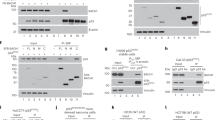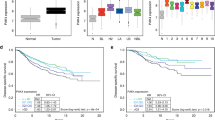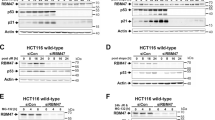Abstract
Oncogene-induced senescence is a p53-dependent defence mechanism against uncontrolled proliferation. Consequently, many human tumours harbour p53 mutations and others show a dysfunctional p53 pathway, frequently by unknown mechanisms. Here we identify BRD7 (bromodomain-containing 7) as a protein whose inhibition allows full neoplastic transformation in the presence of wild-type p53. In human breast tumours harbouring wild-type, but not mutant, p53 the BRD7 gene locus was frequently deleted and low BRD7 expression was found in a subgroup of tumours. Functionally, BRD7 is required for efficient p53-mediated transcription of a subset of target genes. BRD7 interacts with p53 and p300 and is recruited to target gene promoters, affecting histone acetylation, p53 acetylation and promoter activity. Thus, BRD7 suppresses tumorigenicity by serving as a p53 cofactor required for the efficient induction of p53-dependent oncogene-induced senescence.
This is a preview of subscription content, access via your institution
Access options
Subscribe to this journal
Receive 12 print issues and online access
$209.00 per year
only $17.42 per issue
Buy this article
- Purchase on Springer Link
- Instant access to full article PDF
Prices may be subject to local taxes which are calculated during checkout







Similar content being viewed by others
Accession codes
References
Michaloglou, C. et al. BRAFE600-associated senescence-like cell cycle arrest of human naevi. Nature 436, 720–724 (2005).
Chen, Z. et al. Crucial role of p53-dependent cellular senescence in suppression of Pten-deficient tumorigenesis. Nature 436, 725–730 (2005).
Collado, M. et al. Tumour biology: senescence in premalignant tumours. Nature 436, 642 (2005).
Christophorou, M. A., Ringshausen, I., Finch, A. J., Swigart, L. B. & Evan, G. I. The pathological response to DNA damage does not contribute to p53-mediated tumour suppression. Nature 443, 214–217 (2006).
Vousden, K. H. & Lu, X. Live or let die: the cell's response to p53. Nature Rev. Cancer 2, 594–604 (2002).
Bartkova, J. et al. DNA damage response mediators MDC1 and 53BP1: constitutive activation and aberrant loss in breast and lung cancer, but not in testicular germ cell tumours. Oncogene 26, 7414–7422 (2007).
Voorhoeve, P. M. et al. A genetic screen implicates miRNA-372 and miRNA-373 as oncogenes in testicular germ cell tumors. Cell 124, 1169–1181 (2006).
Voorhoeve, P. M. & Agami, R. The tumor-suppressive functions of the human INK4A locus. Cancer Cell 4, 311–319 (2003).
Robinson, K., Asawachaicharn, N., Galloway, D. A., Grandori, C. c-Myc accelerates S-phase and requires WRN to avoid replication stress. Plos ONE 4, e5951 (2009).
Godar, S. et al. growth-inhibitory and tumor-suppressive functions of p53 depend on its repression of CD44 expression. Cell 134, 62–73 (2008).
Ard, P. G. et al. Transcriptional regulation of the mdm2 oncogene by p53 requires TRRAP acetyltransferase complexes. Mol. Cell. Biol. 22, 5650–5661 (2002).
Peng, C. et al. The transcriptional regulation role of BRD7 by binding to acetylated histone through bromodomain. J. Cell Biol. 97, 882–892 (2006).
Sun, H. et al. Solution structure of BRD7 bromodomain and its interaction with acetylated peptides from histone H3 and H4. Biochem. Biophys. Res. Commun. 358, 435–441 (2007).
Kaeser, M. D., Aslanian, A., Dong, M. Q., Yates, J. R. III & Emerson, B. M. BRD7, a novel PBAF-specific SWI/SNF subunit, is required for target gene activation and repression in embryonic stem cells. J. Biol. Chem. 283, 32254–32263 (2008).
Kouzarides, T. Chromatin modifications and their function. Cell 128, 693–705 (2007).
Zhao, Y. et al. Acetylation of p53 at lysine 373/382 by the histone deacetylase inhibitor depsipeptide induces expression of p21 (Waf1/Cip1). Mol. Cell. Biol. 26, 2782–2790 (2006).
Barlev, N. A. et al. Acetylation of p53 activates transcription through recruitment of coactivators/histone acetyltransferases. Mol. Cell 8, 1243–1254 (2001).
Espinosa, J. M., Verdun, R. E. & Emerson, B. M. p53 functions through stress- and promoter-specific recruitment of transcription initiation components before and after DNA damage. Mol. Cell 12, 1015–1027 (2003).
Dornan, D., Shimizu, H., Perkins, H. D. & Hupp, T. R. DNA-dependent acetylation of p53 by the transcription coactivator p300. J. Biol. Chem. 278, 13431–13441 (2003).
Pearson, M. et al. PML regulates p53 acetylation and premature senescence induced by oncogenic Ras. Nature 406, 207–210 (2000).
Luo, J. et al. Acetylation of p53 augments its site-specific DNA binding both in vitro and in vivo. Proc. Natl Acad. Sci. USA 101, 2259–2264 (2004).
Hahn, W. C. et al. Creation of human tumour cells with defined genetic elements. Nature 400, 464–468 (1999).
Argos, M. et al. Genomewide scan for loss of heterozygosity and chromosomal amplification in breast carcinoma using single-nucleotide polymorphism arrays. Cancer Genet. Cytogenet. 182, 69–74 (2008).
Miller, L. D. et al. An expression signature for p53 status in human breast cancer predicts mutation status, transcriptional effects, and patient survival. Proc. Natl Acad. Sci. USA 102, 13550–13555 (2005).
Chin, K. et al. Genomic and transcriptional aberrations linked to breast cancer pathophysiologies. Cancer Cell 10, 529–541 (2006).
Van de Vijver, M. J. et al. A gene-expression signature as a predictor of survival in breast cancer. N. Engl. J. Med. 347, 1999–2009 (2002).
Roepman, P. et al. Microarray-based determination of estrogen receptor, progesterone receptor, and HER2 receptor status in breast cancer. Clin. Cancer Res. 15, 7003–7011.
Hendricks, K. B., Shanahan, F. & Lees, E. Role for BRG1 in cell cycle control and tumor suppression. Mol. Cell. Biol. 24, 362–376 (2004).
Kang, H., Cui, K. & Zhao, K. BRG1 controls the activity of the retinoblastoma protein via regulation of p21CIP1/WAF1/SDI. Mol. Cell. Biol. 24, 1188–1199 (2004).
Xu, Y., Zhang, J. & Chen X. The activity of p53 is differentially regulated by Brm- and Brg1-containing SWI/SNF chromatin remodeling complexes. J. Biol. Chem. 282, 37429–37435 (2007).
Gévry, N., Chan, H. M., Laflamme, L., Livingston, D. M. & Gaudreau, L. p21 transcription is regulated by differential localization of histone H2A.Z. Genes Dev. 21, 1869–1881.
Zhou, J. et al. BRD7, a novel bromodomain gene, inhibits G1-S progression by transcriptionally regulating some important molecules involved in ras/MEK/ERK and Rb/E2F pathways. J. Cell Physiol. 200, 89–98 (2004).
Peng, C. et al. BRD7 suppresses the growth of nasopharyngeal carcinoma cells (HNE1) through negatively regulating β-catenin and ERK pathways. Mol. Cell. Biochem. 303, 141–149 (2007).
Liu, H. et al. Promoter methylation inhibits BRD7 expression in human nasopharyngeal carcinoma cells. BMC Cancer 8, 253 (2008).
Yu, Y. et al. Analysis and molecular cloning of differentially expressing genes in nasopharyngeal carcinoma [in Chinese]. Acta Biochim. Biophys. Sin. 32, 327–332 (2000).
Spruck, C. H. III et al. Absence of p53 mutations in primary nasopharyngeal carcinomas. Cancer Res. 52, 4787–4790 (1992).
Berns, K. et al. A large-scale RNAi screen in human cells identifies new components of the p53 pathway. Nature 428, 431–437 (2004).
Shamir, R. et al. EXPANDER-an integrative program suite for microarray data analysis. BMC Bioinformatics 6, 232 (2005).
Brummelkamp, T. R., Bernards, R. & Agami, R. Stable suppression of tumorigenicity by virus-mediated RNA interference. Cancer Cell 2, 243–247 (2002).
Kolfschoten, I. G. et al. A genetic screen identifies PITX1 as a suppressor of RAS activity and tumorigenicity. Cell 121, 849–858 (2005).
De Vita, G. et al. Dose-dependent inhibition of thyroid differentiation by RAS oncogenes. Mol. Endocrinol. 19, 76–89 (2005).
Kzhyshkowska, J., Rusch, A., Wolf, H. & Dobner, T. Regulation of transcription by the heterogeneous nuclear ribonucleoprotein E1B-AP5 is mediated by complex formation with the novel bromodomain-containing protein BRD7. Biochem. J. 371, 385–393 (2003).
el-Deiry, W. S. et al. WAF1, a potential mediator of p53 tumor suppression. Cell 75, 817–825 (1993).
Müller, M. et al. P53 activates the CD95 (APO-1/Fas) gene in response to DNA damage by anticancer drugs. J. Exp. Med. 188, 2033–2045 (1998).
Mantovani, F. et al. The prolyl-isomerase Pin1 orchestrates p53 acetylation and dissociation from the apoptosis inhibitor iASPP. Nature Struct. Mol. Biol. 14, 921 – 920 (2007).
Livak, K. J. & Schmittgen, T. D. Analysis of relative gene expression data using real-time quantitative PCR and the 2−ΔΔCt method. Methods 25, 402–408 (2001).
Gostissa, M. et al. The transcriptional repressor hDaxx potentiates p53-dependent apoptosis. J. Biol. Chem. 279, 48013–48023 (2004).
Gyuris, J., Golemis, E., Chertkov, H. & Brent, R. Cdi1, a human G1 and S phase protein phophatase that associates with Cdk2. Cell 75, 791–803 (1993).
Ji, H. et al. An integrated software system for analyzing ChIP-chip and ChIP-seq data. Nature Biotechnol. 26, 1293–1300 (2008).
Acknowledgements
We thank Licio Collavin for discussion; Mauro Giacca, Marina Lusic and Lucia Pattarini for access to ICGEB facilities; Thomas Dobner for providing BRD7 expression constructs; Bruno Amati for p300 expression plasmid; Roderick Bijersbergen for assistance in the RNA-mediated interference array experiment; and Joachim Oude-Vrielink and Mariette Schrier for technical assistance. This work was supported by grants from the Dutch Cancer Society (KWF) to J.D., P.M.V and R.A., a European Young Investigator (EURYI) award to R.A. and by the Centre for Biomedical Genetics (CBG) (R.A.), the European Research Council (ERC) (R.A.), the Associazione Italiana per la Ricerca sul Cancro, Ministero dell'Università e della Ricerca (G.D.S.) and by EC FP6 (contracts 503576 and 502963).
Author information
Authors and Affiliations
Contributions
J.D., F.M. and F.T. performed most of the experimental work. J.D., F.M., R.A. and G.D.S wrote the manuscript. P.M.V., R.A. and G.D.S supervised the project. R.E. performed bioinformatical analyses regarding ChIP-sequencing and mRNA expression experiments. A.C. conducted the in vitro pull-down assays. H.H. and J.J. performed the comparative genomic hybridization analysis. R.K. conducted the ChIP-sequencing procedure. P.M.V. contributed to analyses of mRNA expression data sets of human breast tumours.
Corresponding authors
Ethics declarations
Competing interests
The authors declare no competing financial interests.
Supplementary information
Supplementary Information
Supplementary Information (PDF 1319 kb)
Rights and permissions
About this article
Cite this article
Drost, J., Mantovani, F., Tocco, F. et al. BRD7 is a candidate tumour suppressor gene required for p53 function. Nat Cell Biol 12, 380–389 (2010). https://doi.org/10.1038/ncb2038
Received:
Accepted:
Published:
Issue Date:
DOI: https://doi.org/10.1038/ncb2038
This article is cited by
-
BRD7 inhibits enhancer activity and expression of BIRC2 to suppress tumor growth and metastasis in nasopharyngeal carcinoma
Cell Death & Disease (2023)
-
BRD7 suppresses tumor chemosensitivity to CHK1 inhibitors by inhibiting USP1-mediated deubiquitination of CHK1
Cell Death Discovery (2023)
-
Identification of BRD7 by whole-exome sequencing as a predictor for intermediate-stage hepatocellular carcinoma in patients undergoing TACE
Journal of Cancer Research and Clinical Oncology (2023)
-
A novel immune classification reveals distinct immune escape mechanism and genomic alterations: implications for immunotherapy in hepatocellular carcinoma
Journal of Translational Medicine (2021)
-
Exploiting vulnerabilities of SWI/SNF chromatin remodelling complexes for cancer therapy
Oncogene (2021)



